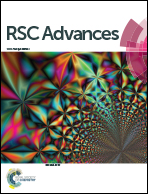Determination of scandium in monazite and environmental samples using cloud point extraction coupled with a spectrophotometric technique
Abstract
A method for the determination of scandium in monazite and environmental samples at trace levels is presented. The Sc(III) complex is preconcentrated using the cloud point extraction process with the nonionic surfactant Triton X-100 to extract the Sc(III) complex from aqueous solutions of pH 5.5. Sc(III) ions were complexed with 2-amino-4-(m-tolyazo)pyridine-3-ol (ATAP) as a complexing agent in aqueous medium and concentrated by Triton X-100 as surfactant. After the phase separation at 45 °C based on the cloud point extraction of the mixture, the surfactant-rich phase was dried and the remaining phase was dissolved with 0.5 mL of dimethylformamide. Under the optimum conditions, the calibration curve is linear for the concentration range of 0.4–65 ng mL−1 and the detection limit was 0.12 ng mL−1. The enhancement factor of 500 was achieved for 250 mL samples containing the analyte with RSDs ≥1.10%. The method is highly selective, fairly sensitive, simple, rapid, economical and safely applied to determine Sc(III) ions in different complex materials, such as monazite and environmental samples.


 Please wait while we load your content...
Please wait while we load your content...